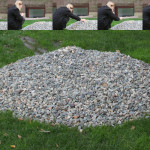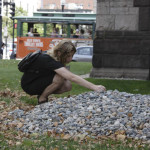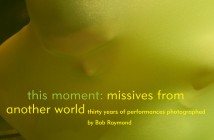As Americans, we live with the luxury of ignorance. Some take pride in educating themselves on war, others ignore it, but unlike the citizens of Iraq or Afghanistan who are immersed in the daily consequences of war, we have the ability to choose what we do with our information. In 2007, Joanne Rice, a local artist and Mobius Artist Group member, committed herself to not only think about the war every day, but also chose to share this commitment with the entire city of Boston.
It is a signature fall day. The air is crisp and there is an excitement radiating from Boston’s annual influx in population. Hope wrestles with melancholy every time the fall chill brushes against the faces of the mass of people rushing around Copley Square. On the side of the Trinity Church sits an unassuming pile of stones. An equally unassuming woman adorned in black stands in a set of tracks that have been worn into to earth in front of the pile. This is the final effort of Rice’s, The Human Cost of War. At noontime, every day for the past two years, Rice has traveled to this site with a white box that contains 100 stones. She deposits the stones, meditating on each one, a symbol of a life lost in war. After this two-year investment, it has all come down to this moment in which Rice stands before this mountain that she has built, little by little, and she must say her farewells.
The ritual is simple:
She stands
Pulls a stone from her box
Holds it
Looks at it
Assigns it an identity
Crouches in front of the pile
Releases it into its appropriate resting place
Stands again
Steps back in remembrance
The cycle repeats.
Rice never breaks this cycle, ensuring that each stone is given a deserving amount of time. It is the intention that Rice gives to this process that makes witnessing The Human Cost of War extraordinary. The choice to create this piece on the grounds of a church feels natural and has given the project accessibility, however it is Rice’s intention that her action could create a sacred space anywhere. As I watch I begin imagining a myriad of places to serve as a setting for Rice and her mountain. I imagine the piece against a tropical sunset, in a shopping mall, a forest, among the ruins of a failed empire, etc. As my imagination runs wild, I recognize the unapologetic and uncompromising fundamentals that have guaranteed this work’s success as a durational piece of art.
I come back to reality and we are in the city - a metropolis that carries on around Rice as she performs this emotive ritual for the last time. A window washer even sets up shop next to her. It’s as if she is invisible, and I am reminded of this common response to the war itself. However, there are people who do stop and engage with her, some of whom have shared this daily action with her for the last 2 years. The people, who are capable of seeing her and this relic for what it is, embody a commitment in their role as witnesses. It may be Rice’s body depositing each rock into the pile, but the action of seeing this happen and evolve is just as crucial to the integrity of the work. It becomes hard to watch this woman shivering, her eyes tearing and nose reddening with the cold. There are moments when it seems mad that rocks could have such a profound effect on a person’s emotional state, but Rice believes in this action with such conviction that we believe in her. This is a piece that needs to be seen, and we need to see her finish what she started. It is in this evolution that we may shift our own paradigm and break the cycle of our cultural love affair with ignorance.
A sign displayed next to the mountain of stones reads:
“ I am thinking about those who have died as kin.
I am thinking of their struggle.
I am praying for peace."
I contemplate what “peace” must means for Rice after this two-year journey. I wonder how the shifts in America’s political climate have informed the piece in its execution and memory. I am hopeful that the departure of The Human Cost of War will lead Rice and those who were fortunate enough to experience it with her into a territory that is rich with possibility, tranquility and rebirth.
- Joanne Rice (pictured), performing The Human Cost of War (2007 – 2009) over several seasons. Photos and composite of last day of performance by Bob Raymond, Mobius Artists Group.
Mobius
The Human Cost of War's was on view from October 7, 2007 through October 6, 2009.
All images are courtesy of Bob Raymond, Mobius Artists Group.
For more about the work, check out Big RED's blog post covering the project.
Click on Big RED's On the Town section for a series of photographs of the performance by Bob Raymond, Mobius Artists Group.







